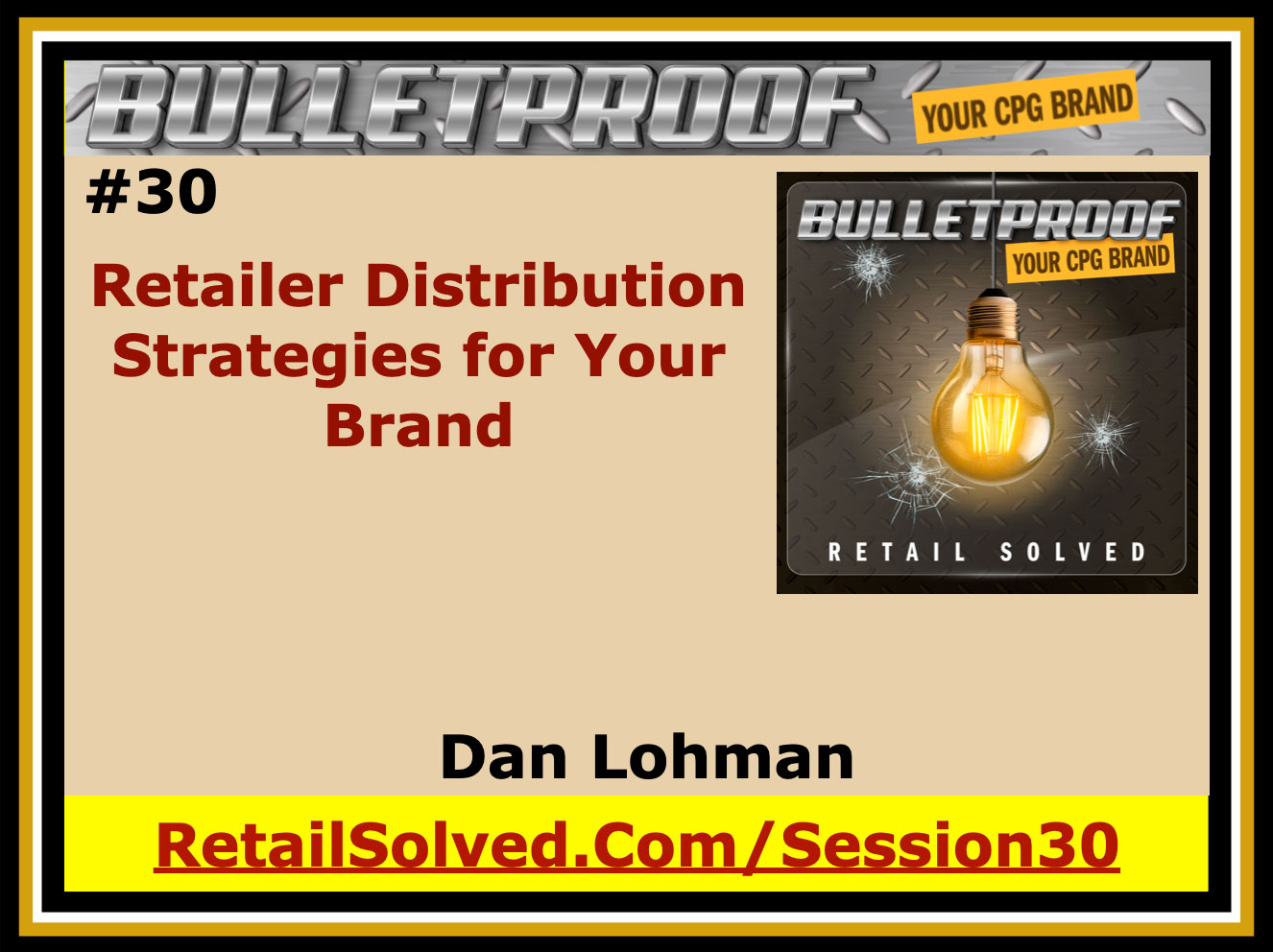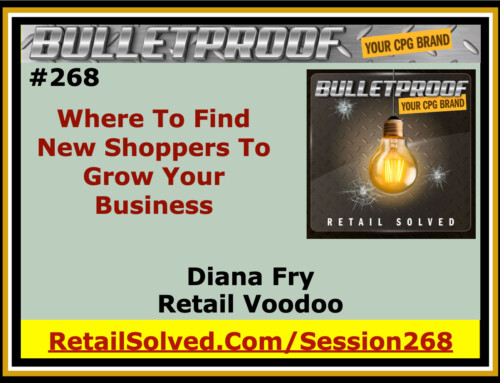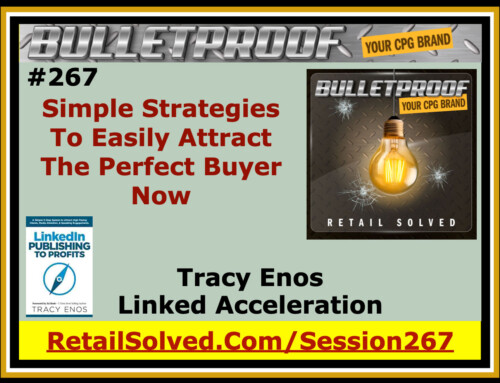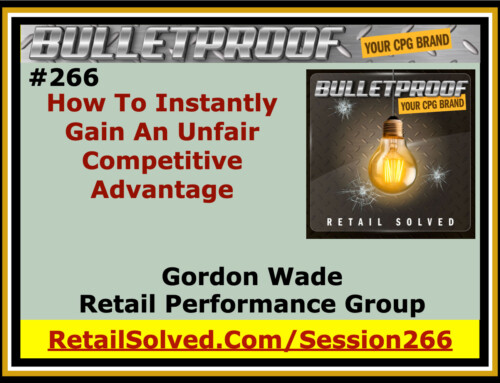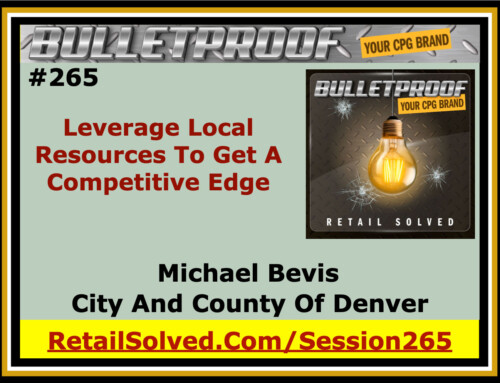Unlock the secrets of successful retailer distribution that can help your brand shine on store shelves and engage shoppers. Getting your brand on retailers’ shelves requires a solid selling story that focuses on how your product can help the retailer drive sales. This involves understanding your product’s position within the store, the consumer who buys it, and how that consumer interacts with other items. A unified voice across all sales channels is crucial to ensure consistent messaging.
Getting your brand on retailers shelves & into the hands of shoppers was the underlying focus of every talk at Expo West. It was echoed by retailers, industry thought leaders & shared by every brand- the reason for my TURNKEY SALES STORY STRATEGIES course.
Listen where you get your podcast
Important: Brand Secrets and Strategies has been rebranded to Retail Solved. Please swap all BrandSecretsandStrategies.com URL’s with RetailSolved.com. This is now the Bulletproof Your Brand podcast. Thank you for listening! BRAND SECRETS AND STRATEGIES PODCAST #30 Hello and thank you for joining us today. This is the Brand Secrets and Strategies Podcast #30 Welcome to the Brand Secrets and Strategies podcast where the focus is on empowering brands and raising the bar. I’m your host Dan Lohman. This weekly show is dedicated to getting your brand on the shelf and keeping it there. Get ready to learn actionable insights and strategic solutions to grow your brand and save you valuable time and money. LETS ROLL UP OUR SLEEVES AND GET STARTED! Welcome. Today's show is about getting your brand on retailers' shelves. Before I get into this, I'd like to do a quick recap on Expo. Expo this year was fantastic. I had an opportunity to talk to a lot of listeners as well as see a lot of brands and a lot of friends. The reason I was at Expo, the primary reason is because I was asked to be, I was honored to be asked to be a mentor for the Pitch-Slam. I was on the selection committee that chose the eight finalists. The brand that I mentored this year was a company called Made Of. They did a phenomenal job, in my mind, a solid number two. They actually made it to the finals four. Dr. Brite is the company that won so congratulations to Dr. Brite. But again, Made Of did a phenomenal job. They were a blast to work with, as were all the different brands that participated. So thank you again for the brands that showed up, that participated, that submitted the applications. It was an honor to be able to look at your information and learn a little bit more about your brand. There's some creative, really disruptive brands coming out in the market so stay tuned. I was able to connect with everyone that sent me a personal note asking me to stop by their booth. One company in particular I need to give a shout out to is Gluten Free Bars. They actually bring everyone together to listen to the podcast, as a team, as a unit. So amazing.That shows you the power of how they can take my message, what I'm sharing with them and leverage it to help grow their sales. Again, this show is about you and it is for you. One of the top themes throughout Expo West this year is how brands get their products on the shelves and what retailers really want and need. This was something that was echoed in many of the different sessions, many of the different leaders, different retail owners, et cetera, and that's why the show is about this and that's what the show is all about anyhow. In addition to that, there were a lot of incubators. Now, some of the incubators were run by large, big mainstream companies but the challenge that I would have there is that there are only a select few companies that can go through this, a select few new brands. The other issue, potentially, is that you're learning how to do things the way that big brands do. One of the biggest points of differentiation that I heard again and again, in many different discusisions, is that natural brands are different than mainstream brands. This is what I talk about all the time. My point being this, that learning how to do things the way that everyone else has been doing it since the dawn of time and I'm being a little facetious here, is not necessarily the best way to do it today. The key is to develop a solid selling story to help get your brand on retailers' shelves. Again, one of the key themes was how do brands position themselves with the retailer to help the retailer grow sales by leveraging their brand? Last week I released my free course, Turnkey Sales Story Strategies. I'll talk more about that later but this entire course is dedicated toward helping those brands do just that. Another key trend that I saw at Expo is what I'm going to call mentorship. Large brands wanting to take small brands under their wing and help mentor them, help guide them and help educate them on the ways to do business, on how to succeed. That's what this show and my courses are all about. So let's talk a little bit about this. Actually, this is why I built the course. This is why I do the podcast. This is why I continue to write articles. I think I've got about 300 in print now globally. The point is this, my goal, my mission is to make our healthy way of life more accessible and the way that I'm going to do that is by helping the small brands succeed and compete more effectively, head to head with the more sophisticated larger brands. So let's talk about today's topic. How to get your product on more retailers' shelves. First of all, current strategies and why they fail. Most brands, when they show up at a retailer's desk, have all their DL sheets. They have all their information in front of them but they don't help the retailer really understand why their product is really unique. Let me explain. I mean, certainly they've got the information in front of them that says that, "This is how people view us. This is what's great about us". The point is this, retailers don't want to be sold just as consumers don't want to be sold. Retailers want the same thing you want. They want to be respected. They don't want to listen to a bunch of brands say me, me, me, me, me. They want the same thing that you want. They want to please their customers. They want to satisfy the people that come into their stores and they want to make a reasonable profit. Brands that stop talking about them so much and start focusing on how they can help the retailer drive sales in their store, now that's a game changer. That changes the conversation to, "How can I help you, how can make things better for you, how can I drive traffic into your store? By the way, here's my brand and here's how I'm going to do this for you." The other way in terms of a better way of looking at this is to really understand how your brand is positioned within the store. Instead of thinking of your product as just a single box, a jar, a can or something, your product is a lot more than that. When a consumer buys your product, what other items are they purchasing at the same time? How does that consumer interact with other items in the store? Retailers need and want your knowledge in this area. They need to understand who the shopper is that's going to come in to buy your product and why that shopper's unique, different or hopefully better than maybe your competition's product. The other key thing is that you need to have a unified voice. Most of the brands that I have worked with throughout my entire career, especially the big brands, do not have a unified voice. You know the game where you tell someone a story and then they tell someone a story and so on and so on and then by the time it gets to about the 10th person, the story is virtually unrecognizable. The point is this, you need to be able to have a consistent message throughout your entire sales funnel. The first person's message, the way they communicate it needs to be identical to the last person. The reason this is important is because you work really, really hard to communicate a message, to put together some great trade marketing information and that gets lost as the message gets passed down through your sales team, through your brokers, through your distributors and to the retailer. Keep in mind that a lot of the retailers have to represent your product to their team. So you've got someone else presenting your product that's not nearly as passionate as you would be. Your retail message, your sales message needs to be very consistent. You need to have a unified voice and you need to be able to communicate that very clearly. You need to be able to articulate, not just what your product is, but who buys your product, what's unique about that consumer and then how that consumer can help drive sales at that retailer. One of the key things of being a category leader is not the ability to crunch a lot of data with a lot of sophisticated tools but rather a category leader is someone, a brand, willing and able to step up and take a leadership role in the category. Remember, retailers cannot possibly be an expert in everything they sell. They need your help. A category leader is a brand that positions themselves as a leader in the category. They help guide the retailer to understand what's sold, how it's sold, the way it should be merchandised, the best way it should be promoted, et cetera. That's what a category leader is and that's what we're ultimately trying to work toward. That's what this show and my courses are all about. While at Expo, talked with alot of industry thought leaders who are thrilled about the opportunity of coming on this show to share information with you. Make sure to check in weekly because I've got some really big names coming on, some exciting interviews that I know you're going to love. So back to today's topic. Another thing you need to know, again, is how to tell your story. Your story has to resonate with everyone. Your story needs to paint a mental picture in the mind of everyone you share it with. They need to put themselves in the shoes of your customer. They need to feel your customer's pain points and they need to see how your products solve the problem that that customer has. Your storytelling is so important and it's got to be more than a good story with a good anecdote or punchline. You need to back it up with some facts. For example, if you're selling something and it's for new moms or new dads, you need to put them mentally in the position of what that parent feels like, what it's like to be that new parent, and then challenge them through your story to understand the different decisions that their core shopper, the core shoppers' are going to be faced. Ironically, this is one of the things I was challenging my pitch-slam brand, Made Of to do. I used to work for Kimberly-Clark. One of the brands that they sell is Huggies. At the time, Huggies was the number one diaper brand in the country and I loved working on the category because I felt connected to the new moms. It was great being able to work in a category on a brand that made such a difference, such an impact, a huge impact on consumers. You might think, "Well, diapers are not very sexy," et cetera. But if you're a parent and you've got to change a lot of diapers in the middle of the night and it makes a mess on the bed, et cetera, you know where I'm going with this. Having a product that works is so very important. Anyhow, working with the guys of Made Of, I was trying to help them get into that position and it was a lot of fun because I would tease them a lot about how they need to get their inner woman on and so on. Anyhow, I don't mean to digress but the point is this, you need to have that empathy, that deep understanding of your consumer. You need to understand what it's like to walk in their shoes. If you can communicate that effectively to the retailer, to your consumer, to everyone in your sales funnel, your sales team, your brokers, et cetera, that's going to help set you apart and ahead of all your competition. To recap, your selling story is the most powerful thing you have to leverage with your brand, for your brand to help you get your brand on retailers' shelves. Help retailers understand who your brand is, who your consumer is. Let them feel your passion. Help them become a brand evangelist for you. Part of being able to tell an effective selling story is to know your numbers. Brands need to understand how the category is progressing, what the trends are on the category, not just from this item's up in sales or down in sales but what are the trends that they see, not only in natural retailers but in other retailers as well? What trends do they see in social networks? So the key point here is know your numbers. You've got to know how your brand fits in. You've got to be able to communicate to the retailer how your brand is going to drive sales on their shelves. Part of that is being able to use canned top line reports, which I know you hear me talk about a lot. It's a great starting place. They provide a quick, instant overview of what's going on in the market so you can see how you're ranked compared to other brands, et cetera. More importantly, the canned reports give you that first view, that first opportunity to look at the category and try to understand why what's happening is happening. Think about that again, why is what's happening happening? In other words, what's happened that drives sales for a certain brand? Did they promote more often? Did another brand maybe lose shelf space or distribution? Then how does that impact you? How does that impact the category? You need to know your numbers. While top line canned reports are good starting point, never ever, ever rely solely on them. This is one of biggest mistakes that brands make. Learn how to understand the data. Learn how to consume and appreciate it and be able to tell a story with it. Why is what's happening happening? Sadly, being able to read reports is not something that's taught very often. That's why I created my Turnkey Sales Story Strategies course for you. The key point is fact based selling. Category management is fact based selling. It's taking your sales story, who buys the product, what they look like, how they shop, ethnicity, demographics, all of that stuff, and putting it together into a story. Fact based selling is going one step further and then being able to share the highlights. For example, sales are up in this category and the sales are driven by millennials. The goal of fact based selling is understand why things are important. Again, why what happened happened? So if you can take the numbers, what the sales trends are in category from a number standpoint, ranking, et cetera, and being able to marry that with consumer data, now you have a much richer story. One that retailer's will appreciate. So now let's talk about the data. There are different kinds of data sources. In my course, I talk about this more. There's consumer data, consumer shopper data, and also syndicated data. First let's talk about syndicated data. Syndicated data is what scans at the retailers register. In other words, at the end of the shopping trip, when you get your registry receipt, what's on it? Well, syndicated data captures that information and then breaks it into categories and segments and that's where you get a lot of the information that fuels the canned top line reports and this is important, the information that you can get to dig deeper down into the category to understand again why what happened, happened. Consumer shopper data is more survey data and it's really designed to understand why a consumer makes the choices they make. The two different data sources are very important to understand. Being able to marry those two different sources together is what's going to give you a leg up at retail. Again, retailers need insights. They need actionable insights. They don't want you to walk up and hand them a canned top line report saying, "Look, we're ranked number five where our sales are up 2%." They want to understand why you're up, why your sales are up, who's down, what's driving sales, who your consumer is and why your brand is more valuable to them on their shelves as opposed to the next guy. Next thing I want to talk about is merchandising. Why it matters and strategies to make shopping easier. Frequently, brands go to a retailer and they try to get distribution. The retailer says, "Okay, thanks. We'll put it on our shelf." But the brand does nothing, absolutely nothing to help guide the retailer on the best ways to merchandise their products. Again, they need your help. What a brand should do is help the retailer with a selling story that includes how to merchandise their products effectively and if they merchandise your product a certain way, what can the retailer expect as a trade-off, gross sales, et cetera. These are key things you need to bake into your sales story. I've included several important merchandising strategies that increase sales in my course, so check it out. I've got several listed there and why they're important. There are different strategies and different tactics brands and retailers can use to maintain your existing consumers, to drive shopper traffic into the section, to drive traffic excitement, excitement into the traffic, et cetera. Know these strategies, learn these strategies and be able to use them to help promote and drive sales in the category. The next thing I want to talk with you about is effective shelf management, product assortment and schematics. By the way, this is actually one of the titles in the course. The reason this is important is because shelf space at a retailer is limited. It's a finite amount of space. What a retailer really sells generically speaking is the amount of space that they sell that your brand occupies. They need to know that they're going to get a certain return on that amount of space. Help the retailer understand what they can expect by merchandising your product at that location. More importantly, help the retailer understand what items are selling and not selling, doing well, performing, not only in their store but across the market and in other stores. This is where the brands need to step up and take a leadership role in the category to help educate the retailers on what they can do to better satisfy their consumers. This is why brands need to be an expert in their products, in their categories, in their competition and in every retailer that they work with. Next thing I want to talk about is effective promotions. You need an effective promotion strategy but most promotional dollars or what they would call trade spending are wasted. They're wasted because they're ineffective. They're wasted because brands have out of stocks or maybe the products aren't merchandised right or maybe there's not enough product to support the demo, et cetera. It's not the retailer's fault if you don't have enough product in stock. You need to help guide them. Remember, consumers don't want excuses. They want to be able to walk into the store and buy your product. When it's on sale, they want to be able to buy whatever they need, one item, two items, et cetera. You need to help the retailer understand that if you discount a product at 50 cents or you promoted it on an end-cap or whatever you decide to do, how much additional product do they need to have in their store to support that promotion, without leaving back stop at the end? That's kind of tricky. But this is something I talk about in this course and in future courses. You need to understand what happens when you drive sales, when you have a promotion. If your sales go up then by how much? Larger retailers have ways to manage some of this. Smaller retailers don't. This is why the brand needs to take full responsibility for their sales. The more you can help the retailer, the more they're going to be willing and able to help and support you. My success throughout my entire career was contingent on how well I supported the retailer. The more I supported the retailer, the more they trusted me, the more that they believed that I could deliver exactly what I promised, the more they would reach out to me and give me incremental promotions. I was able to waive some of the ridiculously expensive fees that they charge, slotting, et cetera. Some of the fees, okay, I get it, I understand that they're there to make money off different areas but the bottom line is this, retailers need shoppers in their stores. The way they get shoppers in their stores is by selling the products that those shoppers want to buy. If you can leverage that to help the retailer drive sales in their store, that's far more valuable to any retailer than a couple of bucks for slotting or a couple of bucks for an end-cap or whatever it maybe. Know your promotion, know the impact of your promotion. Now, one of the key things that you need to understand to be able to really measure this is you need to understand what the true cost of your product is. There are a lot of brands and especially the young brands that I mentor that don't really understand this. They think of everything at their income statement if you will and they say, "Okay, well, here." They divide it by the number of products they sold, "Here's what our cost of goods that's sold is by item." You need to understand exactly how much it costs for each ingredient in each product so that you can more effective calculate what your cost your product is. I mean, if you put a product on a store's shelf and you mark it down during a promotion, do you really know what you're getting at the end of the day and how do you plan for volatility. Say gas prices go up or the price of sugar or whatever you use in your product. The more granular you can be, the better you're going to be able to manage your cost. The better you're able to manage your cost, the better you're able to drive promotions. I have a whole section on this in the course. The other thing is you need to know the true value of your promotions. Remember, I said at the beginning of this, most promotional dollars are wasted. Very few companies really understand this and or understand what it cost to truly promote their product. Now, I'm not saying that, "Well, I paid $3,000 for the menu," or whatever. What I'm talking about is what is the contribution, the amount of money that you give back to the brand and the retailer when you have a promotion? If you can determine that, it's a very complex thing, but I'll try to get to it. I dive into this a little bit in the course. I'll have future courses on this later. But if you can truly understand this then that's one of the key opportunities for you to really help the retailer, not only drive sales within their category, within your brand, but also help the retailer compete more effectively in the market. This is, like I said, a very complicated topic. I had the luxury of working with a large brand years ago where I had full access to an incredible amount of data, incredible amount of resources and I was able to leverage that to build some models, to help understand if I promote at this price, what's going to happen, et cetera. The point being is that I developed a report that is still being used today. This report actually got down to the contribution back to the brand for every given promotion. Now, let me step back a little bit. When I started carrying a sales bag in this industry many, many years ago, it was all about what can I do to get the retailer to take a truckload or a pallet or whatever the product off my hands? It was all about volume, volume, volume. That's a lot of what's going on in the natural today, unfortunately. Category management was created primarily, one of the key points for category management is that category management helps the brand understand and assess what it costs to put a promotion together and what is the contribution back to the brand. It helped eliminate some of the ridiculous wasteful spending that we use to have. It helped streamline inventory levels. This is a real game changer. This is the thing that really made the big change if you will on mainstream retail, mainstream CPG. These are the strategies that I'm trying to teach the small brands so that you have an equal seat at the table with the big brands. So that you can compete, head to head, toe to toe with them. If you want to play at their level, you need to be at their level and again. That's what this course is about, it's what this podcast is about. It's the primary focus of everything I do, helping brands compete more effectively, helping brands get their products on more retailers' shelves and into the hands of more shoppers. An effective selling story, the one that you give to the retailer needs to include all of these elements. It needs to include your commitment to product to the retailer, how are you going to promote it, when are you going to promote it, why are you going to promote it, what can the retailer expect out of it? I shared a lot of tools in this podcast and in the course that will help you better communicate and manage this with the retailer and with your sales team. The next thing, merchandising. You need to not just go to the retailer and say, "Here's my product. Please put it on the shelf." You need to give them a plan, a strategy. Help them understand, fact based, why your product needs to be merchandised on what shelf, et cetera. There are ways to do this and I share many proven strategies in the course. The next thing, your storytelling. You need to have a unified voice throughout your entire sales funnel. It's got to be the same from the first person, from the founder, all the way through to the retailer. You need to ensure that everyone in your sales funnel articulates everything clearly… the benefit of your brand, who buys it, why they buy it, how they buy it. When they buy your product, what other items do they buy along with it? This is the key to your success. This is where most brands fall down. Becoming an expert here will set you apart from your competition. It will give you a sustainable competitive advantage. It will help you become the category leader that earns the trust, the respect and the admiration of the retail community. Remember, retailers need your help. This is how you step up. If you're willing to and you're able to help them, savvy retailers will return the favor. They will reach out to you because they know that you can deliver far more than just a package, a box, an item, et cetera. This is the key to your success. This is how you get your product on more retailers' shelves. This is how you grow your product, get the right distribution and then even transition into other retailers. On the show notes, I'm going to include a link to the course. The link is, the website is brandsecretsandstrategies.com/growsales. Again, brandsecretsandstrategies.com/growsales. The show notes for this episode are going to be located on brandsecretsandstrategies.com/session30. I look forward to seeing you in future shows. I hope you have a chance to take a quick look at the course and see if this is right for you. Again, it's free. It's my way to give back to you. I believe that if I can provide you with a healthy foundation to build your brand on then I can make our healthy way of life more accessible. That's my goal. That's my mission. Thank you again for listening. If you liked the podcast, please subscribe. Tell everyone about it and leave a recommendation on iTunes. I look forward to talking to you the next show. Keep checking back because I've got some amazing thought leaders lined up for future podcasts. You're going to love it. Some of the top people in the industry. Some of the top thought leaders that have the same mission that I have, to improve our healthy way of life, to make food more sustainable, to give back to our local communities and the brands that are really making a difference and to make our healthier as a result. Anyhow, stay tuned because I'm excited about what I'll be bringing you in the future months. Again, thank you for listening and I look forward to seeing you on the next show. This episode's FREE downloadable Your brand's selling story is the cornerstone of all effective business building strategies. Learn How To Get Your Brand On The Shelf and What Retailers REALLY Want. This Is Your Roadmap To Success. CLICK HERE TO GAIN INSTANT ACCESS TO MY FREE TURNKEY SALES STORY STRATEGIES COURSE Thanks again for joining us today. Make sure to stop over at brandsecretsandstrategies.com for the show notes along with more great brand building articles and resources. Please subscribe to the podcast, leave a review, and recommend it to your friends and colleagues. Sign up today on my website so you don’t miss out on actionable insights and strategic solutions to grow your brand and save you valuable time and money. I appreciate all the positive feedback. Keep your suggestions coming. Until next time, this is Dan Lohman with Brand Secrets and Strategies where the focus is on empowering brands and raising the bar.
Enter your name and email address below and I'll send you periodic brand building advice, tips and strategies.
Sign up to receive email updates
FREE Trade Promotion ROI Calculator:
Click Here To Maximize Sales And Profits
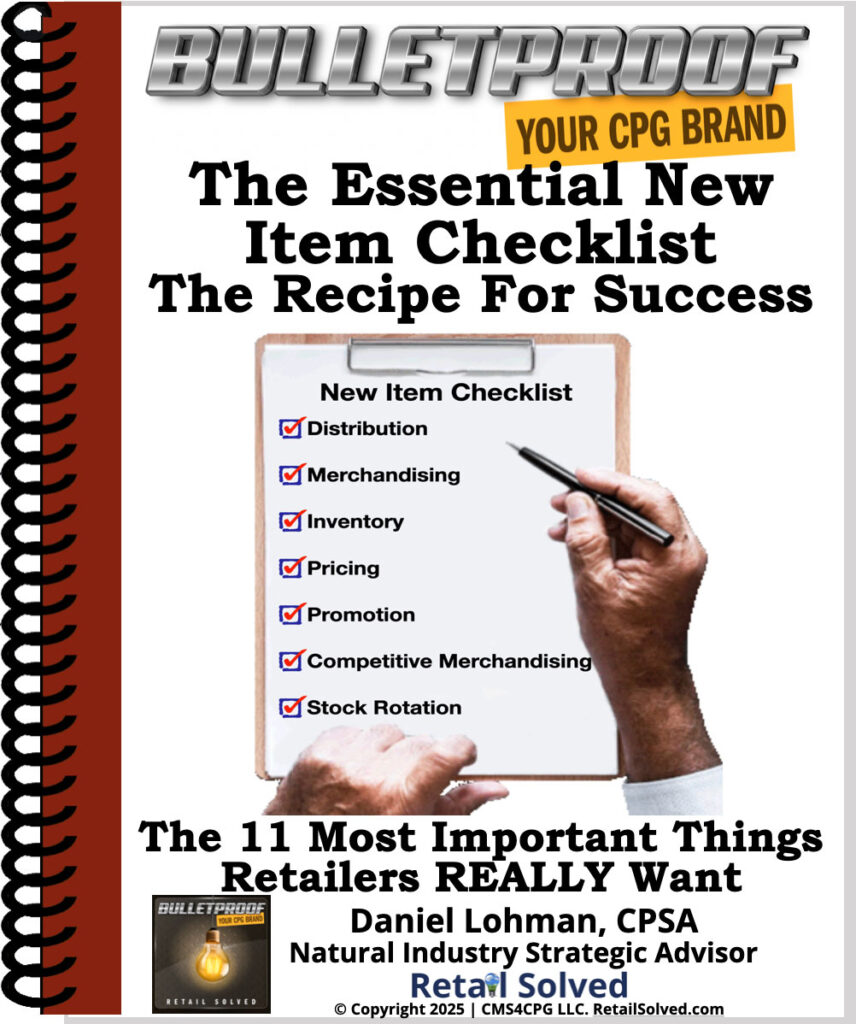
The Essential New Item Checklist – The Recipe For Success
Want A Competitive Edge? The Recipe For Success
New product innovation is the lifeblood of every brand. New products fuel sustainable growth, attract new shoppers and increase brand awareness. Learn the critical steps to get your product on more retailer’s shelves and into the hands of more shoppers. Maximizing your trade marketing can pour rocket fuel on your launch.
Image is the property of CMS4CPG LLC, distribution or reproduction is expressively prohibited.
